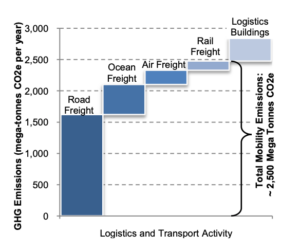A World Economic Forum (WEF) report in 2009 estimated that the logistics and transportation sector contributes approximately 5.5% of greenhouse gas emissions.
1 The report also estimated that logistics buildings contribute 13% of all supply chain emissions within the logistics and transportation sector (Figure 1). While the numbers may have changed since then, the relative percentage of contribution from logistics buildings highlights that warehouses significantly contribute to greenhouse gas emissions. Figure 1 focuses on greenhouse gas emissions, but the impact of logistics buildings and warehouses extends beyond greenhouse gas emissions as these facilities also interfere with the natural ecosystems. Thus, special attention must be paid to logistics warehouses when strategizing to reduce carbon footprint across the end-to-end supply chain. Sustainability in supply chains is a key focus area for companies across industries that use them to deliver products and services. Organizations are actively exploring digital tools and technologies to attain their sustainability objectives as they seek ways to control and reduce their supply chain carbon footprint. Analytics is one tool that can be used to collect and analyze carbon emissions data and build and operate sustainable warehouses.
Figure 1: Emissions from the logistics and transportation sector

Source: World Economic Forum (WEF) report
Warehouses are good candidates for analytics adoption as monitoring and reducing carbon emissions can be tracked efficiently. As Richard Howell, VP of Digital Supply Chain at SAP and a thought leader in supply chain sustainability, highlights, "If you look at most companies' goals or mission statements, they center around sustainability. And our global supply chains sit right in the middle as a major contributor to the climate crisis and as a huge area of opportunity to meet the climate targets. But to be more sustainable, you must start with knowing the current situation, and this is where analytics becomes critical."
AI-enabled Analytics for Designing Sustainable Warehouses
Building location
Warehouse location impacts greenhouse emissions. Suboptimal warehouse location can lead to transportation inefficiencies and add to gas emissions. Traditional network design solutions are crucial in optimal warehouse location selection for minimizing the overall carbon footprint. Most leading network design solutions have the functionality to generate modeling scenarios and measure the carbon footprint impact.
Building design
The World Green Building Council (WGBC) estimated in 2017 that optimal sustainable architecture and design could reduce up to 84 gigatons of CO2 emissions and help accelerate the decarbonization of buildings by the council's 2050 target. Analytics tools play a pivotal role in the designing of green logistics warehouses. Pairing architecture design software with AI-enabled modeling allows planning engineers to look at green scenarios like water usage, waste generation, energy consumption, etc. in the design process. The optimal placement of sensors and other measuring devices for the monitoring process in the operational stage can also be modeled using AI-powered algorithms. AIoT (AI-enabled Internet of Things) plays a crucial role in green building designs, monitoring, and optimizing energy usage.
Layout design
AI-enabled algorithms can be crucial for designing optimal warehouse layouts and flow. Combined with traditional simulation modeling tools, AI algorithms can help develop initial building layouts that focus on minimizing workforce and equipment requirements and distance traveled by workers on equipment, among other things. Factoring this helps in planning strategies to minimize their impact on sustainability.
AI-enabled Analytics for Operating Sustainable Warehouses
AI-enabled automated analytics solutions leverage AIoT-powered edge devices, edge analytics, streaming data, and cloud-based AI-enabled platforms to monitor and optimize energy usage. Many solutions can be easily installed in automated warehouses. These can be plugged into the warehouse’s automation system, and the platform setup occurs remotely in the cloud. These solutions then build a digital twin of the warehouse building to "learn" how the warehouse operates. After a specific duration, the AL algorithm generates audit reports highlighting improvements and adjustments. Many platforms take control of the automation equipment, and edge devices implement adjustments to minimize carbon footprint. While these platforms themselves are rich in features and functionalities, you can leverage the data captured by these solutions to add your own analytics and dashboarding layer.
In addition to monitoring building efficiency, AI-enabled algorithms can minimize warehouses' tactical, operational environmental footprint. From workforce optimization to equipment optimization, AI-enabled optimization solutions can help reduce the resources that are leveraged in the day-to-day operations of warehouses. This, in turn, helps reduce the carbon footprint of warehouse operations. For example, many labor planning solutions leverage AI for optimal warehouse labor planning. If your labor planning solution does not leverage advanced analytics capabilities, it is fairly inexpensive to use open-source tools to build these advanced capabilities on top of existing solutions.
1 World Economic Forum (WEF) report, 2009.










